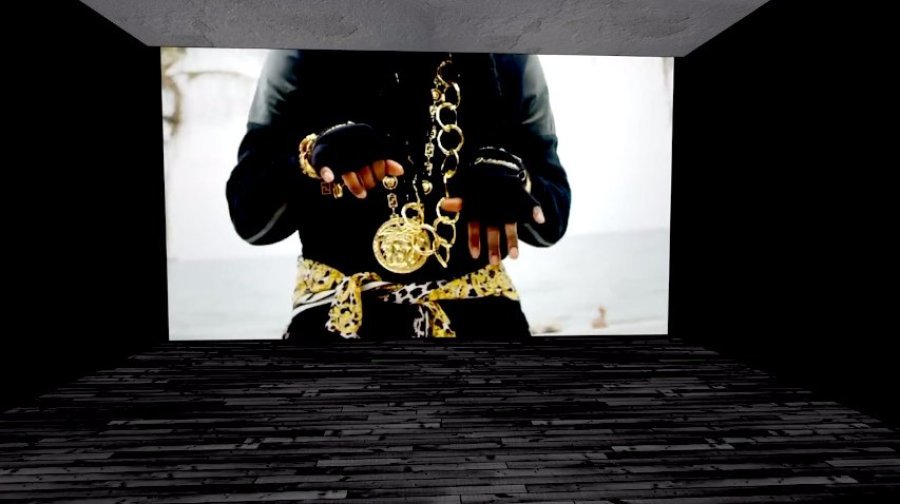When i-D last caught up with New York-based artist and composer Rashaad Newsome, he was fresh off his latest performance of Shade Compositions, a piece (which features costumes from DKNY and Alexander Wang) that explores expressions and actions within black culture, in Austria at the Steirischer Herbst Festival. It’s been just two short months, and the Solange collaborator hasn’t slowed down. Last night, we caught up with Rashaad as he premiered the performative element of his new installation, The Conductor, at Miami’s Select Art Fair.
Can you tell us about The Conductor?
The piece started in 2005 and it was sort of a play between high and low that focused on the gestural language of emceeing. I wanted to figure out who in the emcee world was considered to be the most epic emcees and producers. So I did a survey with local New York radio stations Hot 97 and Power 105 and using the data that came out of that survey, I motion tracked the hands of those artists and the used that library of hand movements to conduct that original piece. So I have six movements, and the sixth movement is not footage that has been motion tracked or edited to conduct the music, these are my hands that were shot on a green screen and they’re mimicking the thousands of different hand movements that came out of the data from the survey. So for me, the video goes from being a video that performs for the viewer into an environment that sort of invites performance.
The Conductor at Select Art Fair 2014 (live performance by Mykki Blanco)
What about the live performance aspect?
I look at the installation as a way to invite artists that came out of the survey to perform within the content of the video. The rule of the piece is that there has to be a performance either on the opening night or somehow during the show where the gallery or space will bring in an artist that came out of the survey or an artist of my choosing. This is the first of that series of performances and I chose Mykki because in a lot of ways, the piece, through the laborious process of making it, reveals things about Hip Hop culture: the misogyny, how it had become this enterprise that people started to really invest in as one of the biggest exports of the United States. It reveals sonic trends within the music because it’s informed by surveys between 2005 and 2012, so there’s a lot of different trends that happened visually and socially. It’s like a portrait of this culture with all its splendour but also with all its flaws.
Mykki Blanco is like a little brother to me and I couldn’t think of anyone else to start the series with. As a black male, he is indirectly connected to the culture but through his gender politics, he’s also outside of it. I’m really fascinated by the way he and so many other kids I’ve worked with have now taken the space for themselves within the culture. I’ve built this house that’s very flawed in some ways, so the whole idea is for them to come in an completely demolish it. So tonight, I’m allowing him to come in and destroy what I built.
Has hip hop always been a source of inspiration for you?
I always listened to Hip Hop music. When I was a kid, I used to rap, I was in a group. I still make music, I have a mixtape that’s coming out with features from a lot of different people that I’ve worked with in the past like Mykki, Cakes Da Killa, Jay Boogie, Ian Isiah, so yeah we’re all doing some stuff together and the mixtape will be coming out next year. But I’ve always been invested in it. In my work, I work a lot with gestural language. W hen I started this piece in 2005, it was coming off the heels of Shade Compositions, which was a gestural language dealing with the performative nature of black vernacular, specifically through the lens of black females, and exploring how that’s something that has sort of become an open source and appropriated all over the world. But this piece is a gestural language that’s more tied to straight males.
Do you think Hip Hop is art?
I think it can be, for sure. Hip Hop in itself as a culture has music, dance, art – it created street art which is a legitimate art form, I mean Swoon Studio is in the booth right behind me, so the proof is in the pudding! It’s a very full culture, so it definitely can be art. I don’t think that people always respect it, I think it’s gotten quite far away from some of the ideas originally, and I think the piece shows that. This is only the sixth movement on a loop, which is how the performance happens, but if you see the installation in its entirety, you can see all of the stuff that’s been pulled from several videos and it tells a story of how this culture’s being documented performatively.
What’s up next for you?
I have a solo show that opens on Tuesday, December 9th at Marlborough Gallery on 57th street back in New York!
Credits
Text Emily Manning
Image courtesy Select Miami
